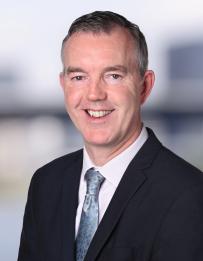A View on the Future of Resilience and Climate Response: A Q&A with Adam Hosking
Global Solutions Director for Resilience and Climate Response explains how Jacobs is supporting communities with the impacts of human and natural hazards and climate change

Resilience is an essential quality for success – the ability to adapt and grow in the face of change and unanticipated events is critical in today’s dynamic, ever-evolving world.
Addressing challenges like population growth, rapid urbanization, natural disasters and climate change, Jacobs works with our clients and their communities to better manage their assets and infrastructure and improve resilience to shocks and stresses.
In this Q&A, we connect with Jacobs Cross-Market Global Solutions Director for Resilience and Climate Response, Adam Hosking. Adam leads our resilience and climate response practice, supporting our clients with solutions that manage present and future risks, protecting people and assets and providing long-term resilience. He shares his perspectives on the challenges that natural hazards, climate change and human-influenced hazards are creating around the globe and how we can think differently to protect and improve the communities we serve.
Tell us a bit about your work as Jacobs Cross-Market Global Solutions Director for Resilience and Climate Response, and what we offer our clients in this space.
In a cross-market role, and especially with a focus on resilience and climate response, every day is different, solving a different challenge in a different place, different sector and for different clients. I am fortunate to work with an exceptional global team of resilience practitioners who bring both domain expertise in our markets and geographies, together with experience in the planning and management of risks. We support our teams globally to bring a resilience lens to our work, ensuring that the planning, delivery and operation of infrastructure is informed by the present and future risks it might face, in order that we can ensure long-term service delivery. This engagement ranges from advisory support to frame policy and strategy, through the integration of future hazards into planning and design, to resilient operations and emergency preparedness and response. While the specific resilience needs and actions vary with context, the importance of thinking long term, and recognizing that the global pace of change means the future will not look like today, is universal.
It’s the combination of our expertise in human-induced hazards, natural hazards, climate change and adaptive solution development, with the domain expertise of our sector teams, that makes our offering unique. We bring differentiated perspectives across our end markets.
What are the biggest resilience challenges today?
Natural hazards, exacerbated by climate change, are a key focus. Flooding, coastal erosion, drought, heat and wildfires have always occurred, but their impacts are growing as we develop in areas prone to these events, and the frequency of occurrence increases due to climate change. The impacts on our built and natural environments can be devastating as we all too often see on the global news. Our resilience practice is fundamentally about the planning, design and delivery of projects that mitigate, and are resilient to, those impacts — all of which are being exacerbated by climate change.
We’re seeing chronic changes with long-term heat and drought, alongside catastrophic events such as wildfires, hurricanes and storms, that aren’t purely being caused by climate change, but are happening more frequently, in different places and with greater intensity. We’ve moved away from a world where we could broadly predict what tomorrow was going to look like, based on the past. That stationarity no longer exists and requires us to anticipate the future without being able to predict it in the same ways we could before. That creates uncertainty for clients and communities looking to manage resources and make long-term investments — what do we plan and design for? There’s real skill and complexity to that and it’s where our resilience team excels.
How are you helping our clients to think differently as they respond to future challenges?
I help our clients understand the conditions they're facing today and what they might look like in the future because there's so much uncertainty around future climate change. We can't know how much we're going to change our emissions globally and we don't have absolute certainty over the mechanisms of climate change, so it’s impossible for us to predict the future climate and what that means in terms of the environment and impacts. We’re supporting our clients to navigate that uncertainty as they make significant investments to manage the risks facing their communities, their assets, their infrastructure and the natural environment. We’re seeing that everywhere, with more and more clients taking action because the changing patterns of natural hazards isn’t something we can ignore anymore. That is really driving our work across water resources.
One specific element seeing a real uptick is coastal resilience. Coastal cities globally are experiencing the impacts of heat and rainfall, but they’re also facing sea-level rise, which is causing increasing occurrences of so-called sunny day flooding. Miami, New York City and many other major coastal cities are facing that challenge, but they don't want to deal with it by building a big wall between them and the sea, because the sea is critical to their community and livelihoods. There’s a lot of focus now in coastal areas on how we can manage this increasing threat to our infrastructure and our communities while providing wider socio-economic and environmental benefits.
Is there a project you’re particularly proud of?
One major infrastructure program implementing a climate resilience strategy is Thames Estuary Asset Management (TEAM 2100). This program was set up by England’s Environment Agency to create a long-term approach to managing tidal flood defenses in London and the Thames Estuary, including the iconic Thames Barrier. Jacobs is managing the first 10 years of the program.
Working collaboratively as an integrated delivery team with the Environment Agency and Balfour Beatty, our job is to plan, inspect, refurbish and improve flood defenses along 330-kilometers of the River Thames and reduce the risk of tidal flooding to protect some 1.4 million people, over 4,000 different assets and over $396 billion (£321 billion) worth of property in London, Essex and Kent. This is part of the Thames Estuary 2100 Plan, which will adapt the riversides to rising sea levels over the next 100 years.
TEAM2100 advocates a programmatic approach to managing tidal flood defenses, aspiring to reduce the overall costs by seeking to invest in the right places at the right time. This major program also aims to deliver greater value for public money through innovation and greater collaboration and joint planning with the supply chain.
About the interviewee

As Jacobs Cross Market Global Solutions Director for Resilience and Climate Response, Adam Hosking is responsible for solutions including business continuity and climate change adaptation services. With a background in coastal geomorphology, he is a Fellow of the Chartered Institute of Water and Environmental Management (CIWEM) and Chartered Scientist with more than 30 years’ international experience in projects and programs addressing climate change adaptation and resilience. He is Chair of CIWEM’s National Climate Change Panel.
Outside of work Adam enjoys walking, cycling, cooking and watching and playing sport. He’s a big Bath Rugby fan and was recently lucky to get a place in the 2025 London Marathon which he’ll be running for Water Aid.














































